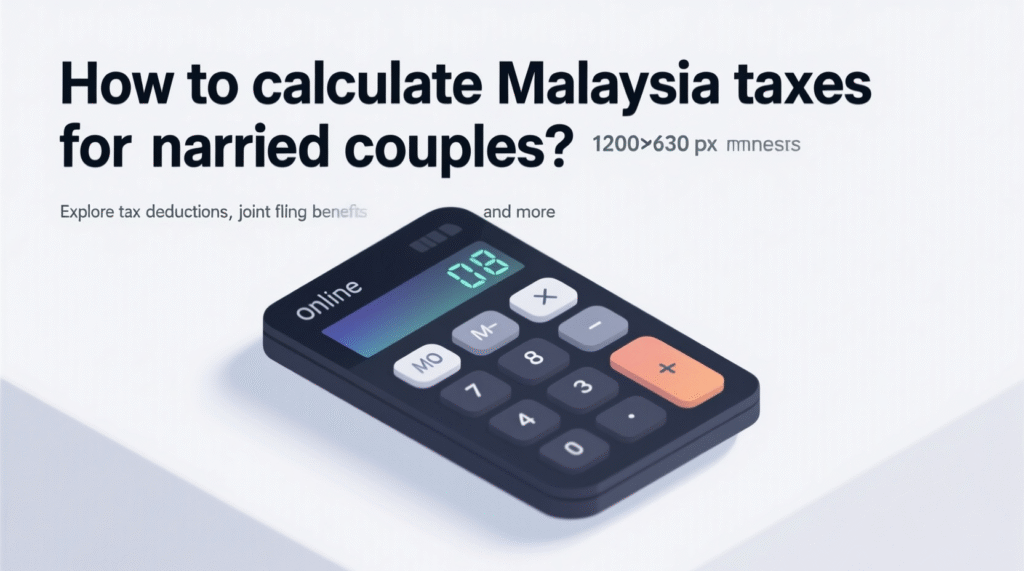
Navigating your income tax as a married couple in Malaysia can be confusing, but understanding your options is the key to significant savings. Do you file separately or jointly? What reliefs can you claim? This guide is designed to help you figure out the best approach to lower your household’s tax bill and make the e-Filing process straightforward.
Separate vs. Joint Assessment: Which is Right for You?
In Malaysia, the LHDN (Lembaga Hasil Dalam Negeri) gives married couples a choice between two assessment methods. Your final tax bill can be drastically different depending on which one you choose.
1. Separate Assessment (Recommended for Most Couples)
This is the most common and often the most financially beneficial option.
- Each spouse files their own individual tax return.
- You both claim your own RM9,000 personal relief.
- You both claim any other applicable reliefs (e.g., for life insurance, EPF, lifestyle expenses, etc.).
- This method allows both incomes to be taxed at lower, separate progressive tax rates, which typically results in a lower total tax bill for the household.
2. Joint Assessment (For Specific Situations)
In a joint assessment, one spouse’s income is combined with the other’s, and the total is taxed under a single name.
- This is only advisable when one spouse has no income or a very low income for the entire year.
- The spouse with the higher income can claim an additional RM4,000 spouse relief.
- Only one set of personal reliefs can be claimed, so you’ll lose the benefit of the second RM9,000 individual relief.
How Do I Calculate My Tax? The 4-Step Formula
Whether you file separately or jointly, the calculation follows the same core process.
Step 1: Calculate Your Total Annual Income
Gather all income sources for the year of assessment. This includes your salary (from your EA form), business profits, rental income, and any other taxable earnings.
Step 2: Subtract All Eligible Tax Reliefs
This is the most crucial part of tax planning. The LHDN offers numerous reliefs to reduce your taxable income. Examples for a married couple include:
- Individual Relief: RM9,000 (per person for separate assessment).
- Spouse Relief: RM4,000 (if filing jointly and one spouse has no income).
- Lifestyle Relief: Up to RM2,500 for things like books, personal computers, and gym memberships.
- Life Insurance & EPF: Up to RM7,000 (combined).
- Medical Expenses for Parents/Serious Diseases: Up to RM8,000 for parents’ medical expenses and RM10,000 for serious diseases.
Step 3: Determine Your Chargeable Income
This is the final amount your tax will be calculated on.
Chargeable Income = Total Annual Income – Total Tax Reliefs
Step 4: Apply the Progressive Tax Rate & Rebates
Use the LHDN’s official tax rate table to calculate the tax on your chargeable income. Finally, subtract any tax rebates you qualify for, such as the RM400 rebate if your chargeable income is below RM35,000.
Real-Life Examples: Separate vs. Joint Calculation
Let’s look at how this works in practice for a couple with two incomes.
Scenario:
- Husband’s Annual Salary: RM100,000
- Wife’s Annual Salary: RM55,000
- Shared reliefs: RM10,000 (e.g., lifestyle, sports equipment)
Option A: Separate Assessment
- Husband’s Chargeable Income: RM100,000 – RM9,000 (individual) – RM5,000 (half of shared reliefs) = RM86,000
- Wife’s Chargeable Income: RM55,000 – RM9,000 (individual) – RM5,000 (half of shared reliefs) = RM41,000
Option B: Joint Assessment (under the husband’s name)
- Combined Chargeable Income: (RM100,000 + RM55,000) – RM9,000 (individual) – RM10,000 (shared reliefs) – RM4,000 (spouse relief) = RM132,000
In this example, the separate assessment results in a significantly lower overall tax bill because the couple’s income is taxed in lower brackets individually.
Frequently Asked Questions
What is the difference between Form BE and Form B?
Form BE is for individuals with non-business income, like a regular salary. Form B is for individuals with business income from a sole proprietorship or partnership.
How do I e-File for a joint assessment?
If you choose a joint assessment, both spouses must still fill out their respective tax forms. One spouse will indicate their income is to be combined with their partner’s, and the tax will be calculated under the main filer’s name.
Can a married couple both claim the RM400 tax rebate?
Yes, if you file separately and both of your chargeable incomes do not exceed RM35,000, you can each claim the RM400 rebate. If you file jointly, you can still only claim one rebate of up to RM400.
What if my spouse has no income?
You should file a joint assessment and claim the RM4,000 spouse relief. Your spouse will not be required to file a separate return, and you will be able to manage the entire process under your single file.
Do I need to keep my receipts after filing?
Yes. The LHDN requires you to keep all supporting documents and receipts for a period of seven years in case your file is selected for a tax audit.
Willium is the creator of IncomeTaxCalculatorMalaysia.com, a trusted resource for accurate and easy-to-use tax calculation tools. With a deep understanding of Malaysia’s tax system, he helps individuals and businesses estimate their income tax with confidence. Willium is dedicated to simplifying financial decisions by offering clear, reliable tools and expert guidance, empowering users to stay informed and save time.
